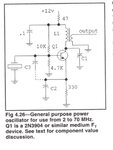musclemania05
Junior Member level 2
Hello so I have two circuit one is a colpits oscillator with a 13.56mhz crystal and the other is a 10watt Continuous Wave amplifier and I'm trying to do the impedance match between the two.
I have a L1 reactance of 450 ohm with 36 turns and I'm trying to drive that to the input of my amplifier circuit with a 50ohm input reactance.
1.to do this would I need 12 turns on the secondary to make 450 look like 50 ohms on the input of the amplifier.
2.once these two are connected and working, I'm suppose to do the impedance matching from the amplifier into a 50ohm dummy load to test, if there is indeed 10watts of power and the 13.56mhz wave. The output of the amplifier consists of low pass filter for harmonic attenuation but this can be ignored. I don't care about harmonics in this project, so from the L-C-C network to a 50 ohm dummy load, can I just connect the dummy load on the out side or do I have to do some kind of LCC network again to match the output impedance of LCC to the 50ohmn dummy load.


I have a L1 reactance of 450 ohm with 36 turns and I'm trying to drive that to the input of my amplifier circuit with a 50ohm input reactance.
1.to do this would I need 12 turns on the secondary to make 450 look like 50 ohms on the input of the amplifier.
2.once these two are connected and working, I'm suppose to do the impedance matching from the amplifier into a 50ohm dummy load to test, if there is indeed 10watts of power and the 13.56mhz wave. The output of the amplifier consists of low pass filter for harmonic attenuation but this can be ignored. I don't care about harmonics in this project, so from the L-C-C network to a 50 ohm dummy load, can I just connect the dummy load on the out side or do I have to do some kind of LCC network again to match the output impedance of LCC to the 50ohmn dummy load.

